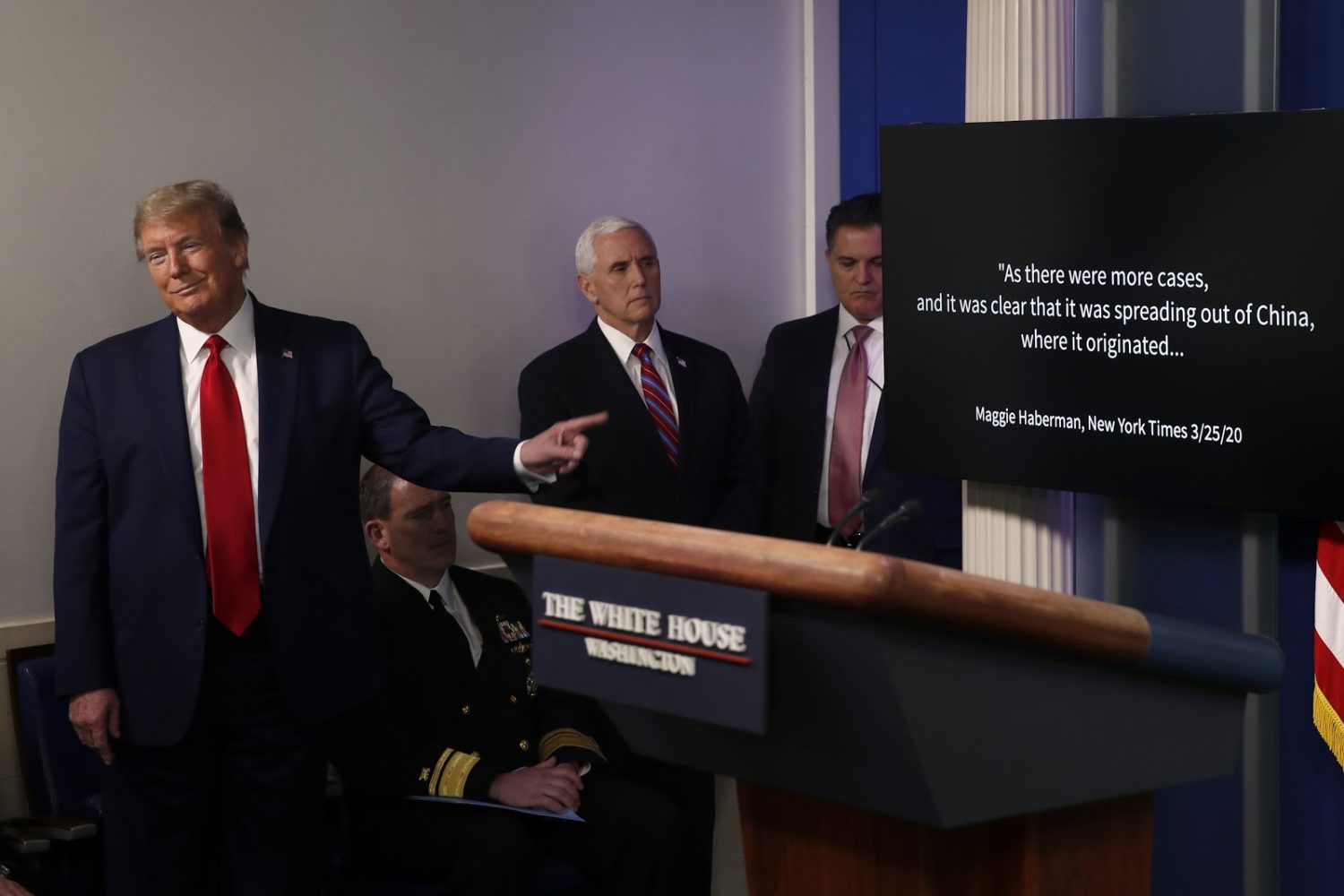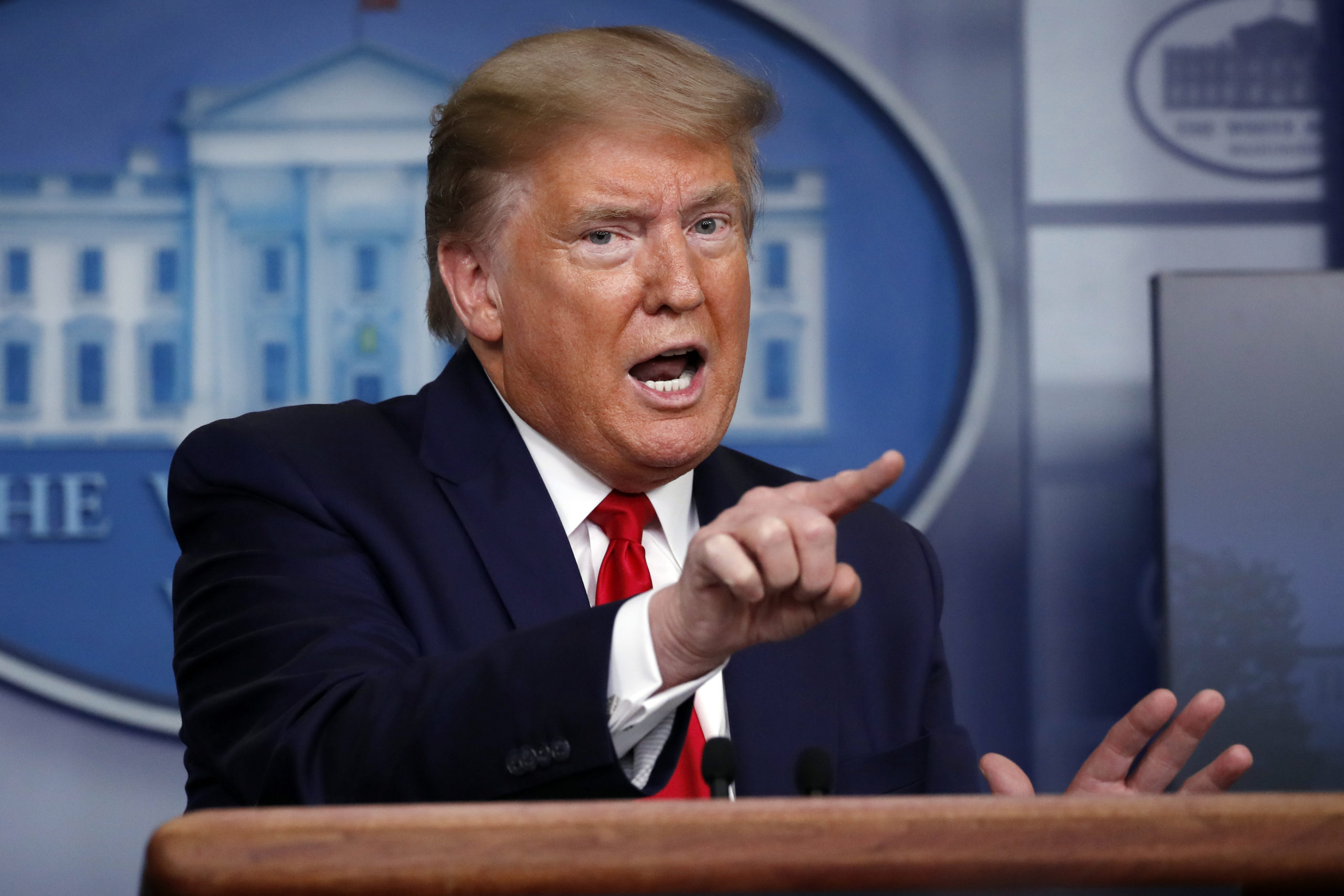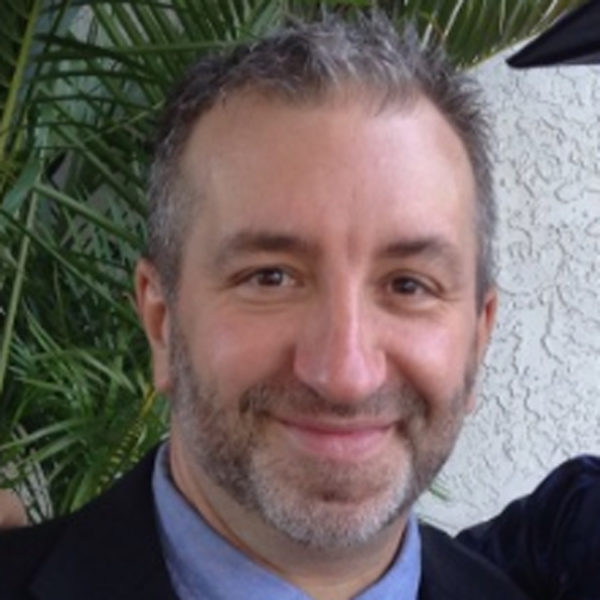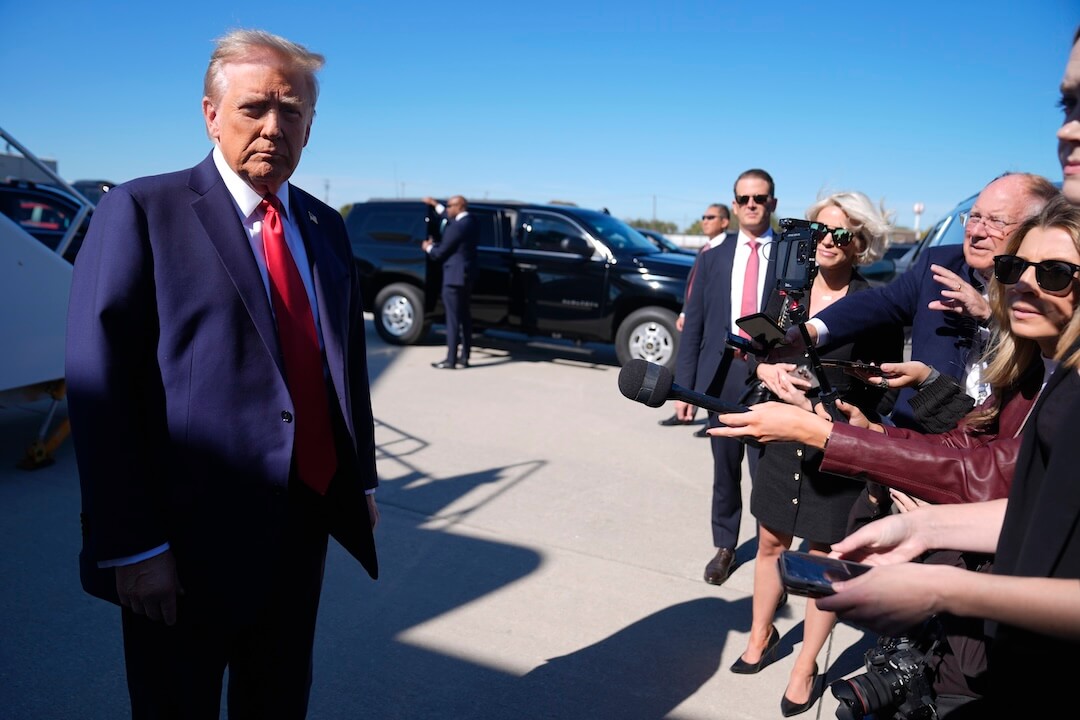The Poynter Report is our daily media newsletter. To have it delivered to your inbox Monday-Friday, click here.
Stunning. Absolutely stunning. Even by White House press conference standards.
It was supposed to be another White House briefing, meant to update the nation on the latest coronavirus numbers, lay out immediate and long term plans and, most of all, calm the nation during one of the scariest moments in our history.
Instead, President Donald Trump drove off the rails, turning the briefing into, perhaps, the most surreal news conference ever seen in the White House. He argued with the media and, in a jaw-dropping moment, showed a slickly-produced video that not only defended his coronavirus response, but attacked the media.
CNN’s John King said on the air, “That was propaganda. That was not just a campaign video. That was propaganda aired at taxpayer expense in the White House briefing room.”
And why did Trump do it? Why did he show the video?
“Because,” Trump told a reporter, “we’re getting fake news and I want to get it corrected.”
That led to a series of combative Q&As with several media members in which Trump continued his “fake news” mantra. Of particular note was a contentious exchange between Trump and CBS’s Paula Reid, who kept peppering Trump with queries about what actions he took during the entire month of February — a line of questioning that led Trump to call Reid “disgraceful.”
As all this was taking place, CNN put the following four banners across the bottom of the screen:
“Angry Trump turns briefing into propaganda session”
“Trump refuses to acknowledge any mistakes”
“Trump uses task force briefing to try and rewrite history on coronavirus response”
“Trump melts down in angry response to reports he ignored virus warnings”
Washington Post media critic Erik Wemple tweeted, “Commentators have often used ‘unhinged’ to describe Trump’s behavior. In so doing, they’ve diluted the heft of the word. In today’s coronavirus briefing, he is truly unhinged.”
CNN’s Jim Acosta, a frequent foe of the president, said, “That is the biggest meltdown I have ever seen from a president of the United States in my career. … He sounds like he is out of control.”
At one point, Trump declared, “When somebody’s the president of the United States, the authority is total. ”
In what was the most brilliant question of the day, CNN White House correspondent Kaitlan Collins asked Trump, “Who told you that?”
CNN’s King called Trump’s declaration “dangerous.”
Eventually, the news conference calmed down to a more civil tone — well, civil by current standards (although Trump and Reid tangled again) — but the first half-hour continued to linger because it was unlike anything that we’ve ever witnessed.
On MSNBC, former New York Times executive editor Howell Raines said, “I think this is one of the astonishing acts of disinformation we’ve seen from a White House since the Vietnam era and the 5:00 follies of the Lyndon Johnson administration. What we are seeing here, I think, is a kind of imploding presidency. And with an implosion, you have to have a black hole at the center. And I think what we have here is a black hole that consists of two elements: President Trump’s extremely fragile ego, and his distrust of government experts.”
It was stunning. Absolutely stunning.
What is fake news?
Among the main themes of Trump’s shocking press conference on Monday was the frequent use of one of his favorite phrases: fake news. It remains a dangerous term, but it is used so often, it has become a cliche.
These days, other dustups between the president and the media draw more attention, such as when he calls a reporter or a question “nasty” or “not nice.” Or like what we saw between him and Reid on Monday. But while those attacks are notable and certainly no fun for the reporters on the receiving end, the phrase “fake news” is meant to do harm.
It brings into question the accuracy of stories. It accuses the reports of being false, made up or intentionally damaging even when there are facts and reliable sources to back them up.
Ultimately, the way Trump and many of his supporters use the term is meant to shift attention away from the story itself. It’s like holding up a shiny object with one hand so that we stop paying attention to what the other hand is doing.
I bring this up again today because Trump has ramped up his use of the phrase in recent days and said it throughout Monday’s news conference.
Fake news — or, more accurately, what it really means — was also the topic of the latest column from Washington Post media columnist Margaret Sullivan, written before Monday’s press conference.
“… the history of the Trump administration has shown that the loudest cries of ‘fake news’ accompany the most damning journalism,” Sullivan wrote.
“Coming from him, the phrase now dependably has another meaning: ‘all-too-accurate reporting that damages my reputation.’”
This past weekend there was plenty of damning journalism, from a major piece in The New York Times about how slow Trump’s coronavirus response was to a “60 Minutes” interview with White House trade adviser Peter Navarro in which Navarro challenged the iconic show to produce proof that it talked about a pandemic before Trump was president. Then, of course, the show proved it by airing clips from 2009 and 2005 — which included an interview with a doctor by the name of Anthony Fauci.
In both cases, the stories were based on facts. The Times story — the one that seems to have Trump particularly distressed these days — not only talked to plenty of on-the-record sources, but had written proof in the form of emails. The “60 Minutes” story simply pulled out old clips to prove it had done stories on pandemics during the Barack Obama and George W. Bush administrations.
Often, the best way to dismiss such a story is to slap a “fake news” label on it, knowing that supporters who already distrust the media need nothing more than that term to be satisfied.
As long as that’s good enough for his supporters, it will be good enough for Trump to keep saying, and the facts of the story, he hopes, will go ignored. So don’t expect that phrase to disappear anytime soon. Or ever, especially after Monday’s free-for-all.
What about these news conferences?
Only C-SPAN showed Monday’s entire press conference, which went well beyond two hours. Fox News showed a little more than two hours before going to Tucker Carlson. CNN and MSNBC showed most of the first 90 minutes before cutting out. The major networks — NBC, ABC, CBS — showed none of it.
And so here we are again: Should networks air these briefings, especially after Monday’s bizarre turn? Or, another question: Should reporters even attend? Even before Monday’s news conference, New York University journalism professor and media observer Jay Rosen asked (and answered), “Why don’t reporters just walk out?”
You could make the argument that Trump’s antics Monday needed to be seen to be fully appreciated by the American people. But there’s no question that Trump’s video felt like a campaign ad, thus lending credence to the idea that Trump is treating these briefings as the rallies that he can’t hold because of coronavirus.
Appearing on MSNBC, “PBS NewsHour” White House correspondent Yamiche Alcindor said, “I think what we saw today was really a remarkable moment of the president just being openly candid about the fact that he is using these briefings as a way to talk about his own reelection campaign. And a way to push back against people he feels threatened by. He’s clearly threatened by the dogged reporting of The New York Times, of NBC, of other networks, of other newspapers that are showing all of America that he made big mistakes when it came to the coronavirus.”
Work that deserves your attention
If you haven’t already seen this, stop whatever you are doing and read this piece from The Washington Post. Written by Abigail Hauslohner, Reis Thebault and Jacqueline Dupree, with contributions from more than a dozen others, the Post looks back at the first 1,000 in the United States to die from the coronavirus.
As the Post respectfully points out, “Behind every data point on a curve or chart is a name and story of the earliest victims.”
This is elite-level journalism with heartbreaking stories and photos, smart graphics and superb design and analysis. This is excellent work that puts names and faces to a story that is far too often politicized, and reminds us truly what is happening right now.
Scenes from a city
Associated Press enterprise photo editor Enric Martí and enterprise photographer Wong Maye-E, formerly AP’s chief photographer in North Korea, jumped on a motorcycle and rode through the streets of New York City to show what life is like there during the coronavirus. The superb video with narration from the two photojournalists was shot on 12 different rides all over New York — from Greenwich Village to Harlem to Brooklyn, Queens and the Bronx.
What’s especially interesting, as the two describe, is how in sync they were with each other as photographers. As an example, Martí, driving the motorcycle, would point to a shot only to find out that Wong already had her camera pointed there. The 4-minute video is well worth your time.
Asking for help
Sports Business Journal’s John Ourand reports that ESPN has asked its 100 highest paid commentators to take 15% pay cuts over the next three months to deal with the impact of the coronavirus and the fact that there are virtually no sports right now. (Though it should be mentioned that some of the network’s top earners, such as Mike Greenberg and Stephen A. Smith, continue to work daily.) According to Ourand, top ESPN executives spent much of Monday morning talking to talent and their agents about what is, for now, a voluntary pay cut.
Ourand wrote, “ESPN executives appealed to the commentators and their agents that these cuts would deter further furloughs for ESPN employees who may be in more precarious financial positions than some of the on-air commentators.”
In a statement, ESPN said, “We are asking about 100 of our commentators to join with our executives and take a temporary salary reduction. These are challenging times, and we are all in this together.”
New York Post sports media columnist Andrew Marchand reported that, almost immediately, talent such as Smith, Scott Van Pelt, Dick Vitale, Mark Jackson, Mike Breen and Jay Bilas agreed to take temporary pay reductions.
Racing to a cure
“CBS Evening News” launched a new weeklong series Monday night called “Racing to a Cure,” which looks at the search for treatments and vaccines for the coronavirus. Besides being shown on the “CBS Evening News,” there is additional reporting on CBS News’ Twitter, Facebook and Instagram accounts.
In a statement, Jay Shaylor, the executive producer of the “CBS Evening News” said, “Medicine is the only way we will ultimately beat this horrible disease. That’s why we are shining a light on the cutting-edge research being done in the United States and around the world.”
Media tidbits
- NBC continues with its weekly “NBC News Special Report: Coronavirus Pandemic” tonight at 10 p.m. Eastern on NBC, MSNBC and NBC News NOW. Tonight’s special will be hosted by Savannah Guthrie and Hoda Kotb.
- Kara Swisher’s “Pivot” podcast from Vox Media is joining New York magazine and Swisher will be an editor-at-large for New York magazine, as well. Swisher co-hosts “Pivot” with NYU professor Scott Galloway as they talk about tech, business and politics. By the way, in case you missed it, The Daily Beast’s Lloyd Grove had a nice recap of the recent feud between Swisher and Fox News’ Sean Hannity that started with a Swisher blaming Fox News for spreading false information about the coronavirus in a column for The New York Times.
- Funny line of the day from New York Gov. Andrew Cuomo, when responding to an MSNBC question about not having to face questions about his upbringing or childhood nicknames — you know, the kind of questions he gets from his brother, Chris, on CNN. “This is much nicer than what I go through on some other shows,” Cuomo said. “Trust me.” Last week, New York Times media columnist Ben Smith wrote, “Americans Don’t Trust the Media Anymore. So Why Do They Trust the Cuomos?”
- The Alligator — an independent student newspaper at the University of Florida — uncovered a case of alleged plagiarism in one of its music reviews. It was caught before it was published and an internal investigation led to more cases of believed plagiarism. The paper’s editors wrote about it.
Hot type
- It almost feels like “Night of the Living Dead” or “World War Z” or “The Walking Dead.” That is, we foolishly turn those impacted by coronavirus into monsters, or something evil. Poynter’s Roy Peter Clark on never equating illness with evil, or culture with disease.
- ProPublica’s Beena Raghavendran and Ryan McCarthy with “How Panic Buying Has Put an Incredible Strain on Food Banks Even as the Need for Them Explodes.”
- Writing for Forbes, Avivah Wittenberg-Cox notes that many of the countries with the best coronavirus responses have one thing in common: women leaders.
- Finally, and sadly, today, Poynter’s Kristen Hare is keeping tabs of journalists we have lost to the coronavirus.
Have feedback or a tip? Email Poynter senior media writer Tom Jones at tjones@poynter.org.
More resources for journalists
- On Poynt Live training: April 16 at 2 p.m. Eastern — COVID-19 Data Sources to Make Fact-Checking Easy — Poynter
- Covering COVID-19 with Al Tompkins — Poynter
- Covering Coronavirus: Life and Death Decisions, April 15 at 1 p.m. Eastern — Center for Health Journalism, USC Annenberg
- When the newsroom becomes your living room: Reporting in the age of COVID-19, April 17 at 7 p.m Eastern — National Association of Hispanic Journalists
Want to get this briefing in your inbox? Sign up here.










